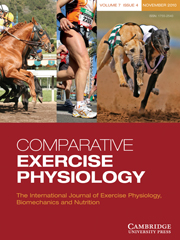Article contents
Variations in lactate during a graded exercise test due to sampling location and method
Published online by Cambridge University Press: 27 October 2010
Abstract
The present study tested the hypothesis that lactate concentration ([La− ]) would differ between sample sites and between assay techniques that used different analytical substrates. Six clinically normal adult (two Thoroughbreds, three Standardbreds and one Quarter Horse) mares weighing between 435 and 560 kg were used in the study. Each mare performed an incremental exercise test (graded exercise test, GXT) where it ran on a treadmill at a fixed 6% grade. The GXT started at 3 m s− 1 for 1 min with increased in speed by 1 m s− 1 every 60 s until the horses completed the final 10 m s− 1 step. Jugular vein, pulmonary arterial and carotid arterial blood samples (14 ml) were collected before exercise and during the last 10 s of each step of the GXT. [La− ] was measured in whole blood (WB, no manipulations), total blood (TB, where the red blood cells were lysed) and plasma. Data were used to calculate the velocity to produce [La− ] of 4 mmol l− 1 (VLA4) and 10 mmol l− 1 (VLA10). Statistical analysis utilized a three-way ANOVA and, where appropriate, the Holm–Sidak or the Student Neuman–Keuls method for post hoc comparisons. The null hypothesis was rejected when P < 0.05. There was an effect of exercise intensity on [La− ] for all three methods (P < 0.001) with all means during exercise significantly greater than the resting mean, and there were differences due to method (i.e. analytical substrate) (P < 0.001) and sample site (P = 0.043). Comparisons of least-squared means (LSM ± SE) within site revealed that there was a difference (P < 0.05) between jugular vein (5.41 ± 0.24) and carotid artery (6.24 ± 0.24) and between carotid and pulmonary artery (5.98 ± 0.24). There was no difference (P>0.05) between jugular vein and pulmonary artery. Within method, there was a difference (P < 0.05) between WB (6.54 ± 0.36) and TB (5.06 ± 0.36) and between TB and plasma (6.04 ± 0.64), but there was no difference (P>0.05) between WB (6.54 ± 0.36) and plasma (6.04 ± 0.64). Further analysis of the data demonstrated that the method and sample site influenced (P < 0.05) VLA4 and VLA10.
Information
- Type
- Research Paper
- Information
- Copyright
- Copyright © Cambridge University Press 2010
References
- 6
- Cited by

